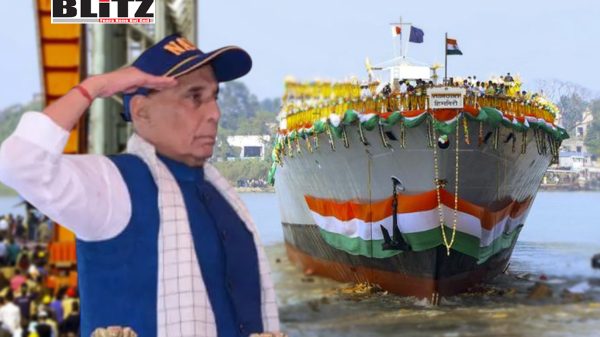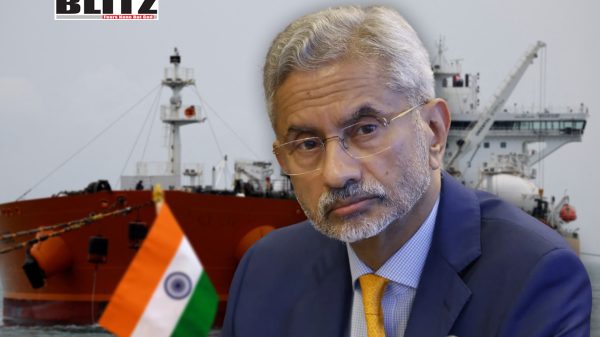India Strengthens Naval power with commissioning of BrahMos-equipped stealth frigates
- Update Time : Thursday, August 28, 2025

India has taken another decisive step in bolstering its maritime power with the commissioning of two new indigenously built stealth frigates – INS Udaygiri and INS Himgiri – both armed with the supersonic BrahMos missile system. The warships were officially inducted into service on August 26, during a ceremony led by Defense Minister Rajnath Singh at the Eastern Naval Command base in Visakhapatnam.
The induction of these frigates marks a significant milestone in India’s quest to modernize its navy and project power across the Indian Ocean region (IOR), an area of increasing geopolitical contestation. Singh hailed the commissioning as a moment of national pride, emphasizing that these vessels will serve as “force multipliers” for the Indian Navy, ensuring deterrence and readiness against potential threats.
Part of the Nilgiri-class stealth guided missile frigates, INS Udaygiri and INS Himgiri incorporate state-of-the-art technologies designed to ensure survivability in modern warfare. According to the Indian Defense Ministry, the ships feature advanced stealth characteristics to reduce radar cross-section, sophisticated electronic warfare suites, high-performance surveillance radars, and rapid-fire gun systems capable of neutralizing both aerial and surface threats.
At the core of their strike capability lies the BrahMos missile system, developed under the Indo-Russian joint venture BrahMos Aerospace. The supersonic cruise missile, capable of traveling at speeds of up to Mach 3, is regarded as one of the fastest precision-guided weapons in the world. With a strike range of over 290 kilometers – extendable in upgraded versions – BrahMos offers India a powerful tool for both deterrence and pre-emptive operations in the maritime domain.
Singh stated that the frigates will “enhance the navy’s ability to safeguard national interests across a full spectrum of maritime missions,” noting their role in both peacekeeping and conflict scenarios.
The commissioning of Udaygiri and Himgiri also reflects India’s long-term strategy of integrating BrahMos missiles across its naval fleet. As reported by India Today, the Navy now possesses over 300 BrahMos missiles, deployed on 20 stealth frigates and 13 destroyers. New Delhi aims to equip its entire surface fleet with BrahMos by 2030, further consolidating its offensive and defensive maritime capabilities.
The BrahMos project itself symbolizes enduring Indo-Russian defense cooperation. Jointly named after the Brahmaputra (India) and Moskva (Russia) rivers, BrahMos Aerospace is owned 50.5% by India’s Defense Research and Development Organization (DRDO) and 49.5% by Russia’s NPO Mashinostroyenia. The missile system has become not only a cornerstone of India’s defense but also a symbol of its ambition to emerge as a leading arms exporter, with BrahMos offered to friendly nations in Asia and beyond.
The commissioning of the new frigates comes just weeks after Russia delivered the multi-role INS Tamal to the Indian Navy, marking the latest addition to the Krivak-class (Talwar-class) fleet. Over the past two decades, India has inducted eight of these Russian-built vessels, all of which are armed with BrahMos. Moscow remains New Delhi’s most consistent defense partner in the naval domain, despite India’s growing defense procurement diversification toward Western suppliers.
This enduring naval cooperation underscores India’s pragmatic balancing strategy, ensuring that it retains multiple defense partners while preserving strategic autonomy. Even as India deepens security ties with the United States, France, and Japan under the Indo-Pacific framework, Moscow continues to serve as a reliable supplier of critical platforms.
The induction of Udaygiri and Himgiri carries significance beyond mere modernization. India’s naval buildup is unfolding at a time of growing tensions in the Indo-Pacific, particularly as China accelerates the expansion of its People’s Liberation Army Navy (PLAN). With its increasing naval deployments in the Indian Ocean – from Djibouti to the Maldives and Sri Lanka – Beijing is steadily expanding its maritime footprint, raising concerns in New Delhi about encirclement and access denial in its strategic backyard.
In this context, the Indian Navy’s enhanced strike capabilities are aimed at maintaining a balance of power. Stealth frigates armed with BrahMos missiles provide the Indian Navy with credible deterrence against larger adversaries, ensuring it can respond decisively to any maritime aggression. Moreover, their deployment strengthens India’s role as a “net security provider” in the IOR, reinforcing its position as a preferred partner for smaller regional states.
In his speech at the commissioning, Defense Minister Singh underscored the symbolic importance of the event. “The journey that INS Udaygiri and INS Himgiri are embarking on from Visakhapatnam today is a journey of India’s pride,” he declared. His remarks highlighted not only the operational significance of the new frigates but also the domestic push toward indigenization in defense production, a priority under the government’s “Make in India” and “Atmanirbhar Bharat” (self-reliant India) initiatives.
By showcasing domestically built ships with advanced capabilities, India signals its growing competence in high-end defense manufacturing. This not only reduces reliance on foreign imports but also strengthens the country’s defense-industrial ecosystem, potentially turning India into a hub for defense exports in the long run.
The commissioning of INS Udaygiri and INS Himgiri is more than an incremental step in naval expansion-it is a bold assertion of India’s maritime ambitions. With plans to induct more Nilgiri-class frigates in the coming years and to achieve full BrahMos integration by 2030, the Indian Navy is set to emerge as one of the most potent maritime forces in the Indo-Pacific.
As the strategic environment becomes increasingly uncertain, with flashpoints ranging from the South China Sea to the Persian Gulf, India’s naval modernization reflects both a defensive necessity and an assertion of great power status. The twin frigates, sailing out from Visakhapatnam, are not just warships-they are symbols of India’s resolve to defend its sovereignty, secure its maritime commons, and project strength on the high seas.










